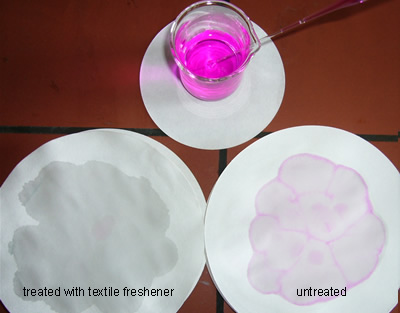|
1. Extraction of Cyclodextrins from Everyday Products and Detection |
||||
It takes 40 – 50 minutes to evaporate the liquid textile fresheners. Details of a simple alternative are given in the “Hints and Comments” section. It takes only a few minutes to test for the presence of cyclodextrin in the samples. |
||||
|
||||
This experiment is used to test different textile fresheners for the presence of cyclodextrins. Evaporation of the liquid textile fresheners, however, does not yield a powdery pure substance, but rather a paste. The formation of a host-guest complex with phenolphthalein and the corresponding decolorization of the red-violet phenolphthalein solution serves as a test for cyclodextrins. If the color of the solution does not fade, then the textile freshener contains no cyclodextrin or only a very small concentration. |
||||
| Some of the textile fresheners contain cyclodextrins because they decolorize the alkaline phenolphthalein solution. No cyclodextrin can be detected in one of the textile fresheners. In the absence of a hot plate, a Bunsen burner can be used to evaporate the solutions. In this case, especially when evaporating almost to dryness, the solution must be heated gently to prevent thermal decomposition of the cyclodextrins. A very simple variant can also be used to test liquid textile fresheners for cyclodextrins: Spray the textile freshener onto a piece of filter paper. Allow to dry and then repeat the spraying twice more. Then test the sample as described above. | ||||
 |
||||
| Abb. 2.21: Verschiedene Textilerfrischer | ||||
An additional experiment can be performed using the extracts from the textile fresheners. Filter paper treated with the extract from the textile fresheners can also be used in the experiment to mask the smell of cigarette smoke, as an alternative to cotton strips. |
||||
The decolorization of the magenta-colored phenolphthalein solution can be attributed to the complexation of the phenolphthalein dianion in the cyclodextrin molecule. Further information can be found in the experiment “Host Guest Complex: β-Cyclodextrin and Phenolphthalein” and in the flash animation. |
||||
|
||||
